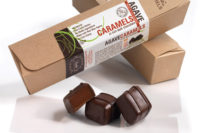Caramels
These fall favorites benefit from new product innovation and recipe-focused merchandising strategies.
Overview
You might say that caramel as a flavor is
simultaneously traditional and trendy. Caramels have been popular in the
United States since the 1880s, and yet recently, the flavor has acquired
new cachet as an up and coming ingredient in everything from Starbucks
beverages to cookies, cakes, ice cream and more.
Sales of traditional caramel confectionery SKUs have
declined a bit in food, drug and mass channels in recent years, but
it’s still a powerhouse category. Americans consume more than 10
million pounds of caramel annually as snacks and as ingredients.
Fortunately, caramel makers have begun to apply some
new product creativity to the category. One excellent example is the
pairing of caramel and chocolate; sales of products formulated with this
dynamic ingredient duo have grown by 9.5 percent for the past three
consecutive years. Thus it’s not surprising that one major player in
this segment is currently test marketing three variations on the
caramel/chocolate theme — including one formulated with traditional
European chocolate surrounding a liquid caramel center.
Target Audience
Caramel lovers tend to skew a bit older than many
candy purchasers. Women ages 35 plus are a key target audience, but that
doesn’t mean there’s not a strong opportunity for kid-oriented
products as well, particularly with the availability of fruit-flavored
caramel products or caramel apple flavor options.
Seasonal Opportunities
The caramel category is highly seasonal, although not
in the “big four candy holidays” sense. From mid-August to
mid-October, caramel consumption is about three times as great as it is
during the rest of the year. Of caramels purchased during that timeframe,
about 15 percent are used for baking, according to one leading caramel
maker. During the rest of the year, baking applications account for about 7
to 8 percent of caramel purchases.
Thus there’s a golden opportunity for retailers
to drive even more fall caramel sales with recipe-focused promotions at the
store level and by taking advantage of vendor promotions that encourage
cooking and baking with caramels.
Outlook
Upscale/gourmet caramel creations, products that pair
chocolate and caramel, and sugar-free caramel formulations targeted to the
boomer consumer are all expected to continue to add vitality to this
creamy, chewy subset of the confectionery category.
$55.4
million
Chewy Caramels Estimated U.S. Retail Market Size*
*In food, drug and mass merchandisers, excluding Wal-Mart
Source: Information Resources Inc.
Chewy Caramels Estimated U.S. Retail Market Size*
*In food, drug and mass merchandisers, excluding Wal-Mart
Source: Information Resources Inc.
Merchandising Musts
• At home in the produce
department. This section of the store is a
natural for secondary caramel displays, particularly those that encourage
shoppers to prepare a caramel apple pie or some caramel-covered apples.
• Go for the cluster
effect. To make a strong statement at
retail, consider creating a caramel subset in the candy section. Position
caramel candy in peg bags directly above caramels in laydown bags, so
shoppers may easily seek out their caramel SKU of choice.

